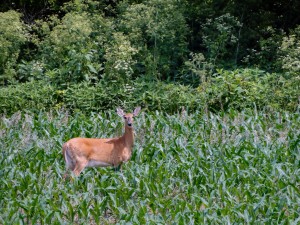By Sarah Coefield
Coefield@msu.edu
Great Lakes Echo
Sept. 23, 2009
Countless deer descend on crops in the Great Lakes region, leaving in their wake torn corn silks, leafless soybeans, devastated orchards and millions of dollars in damage. It’s a drop in the bucket for the agriculturally rich region but nonetheless painful for individual farmers.

A doe surveys an Indiana cornfield. Photo by Cindy Seigle
“In the grand scheme of things, it’s a minor amount, but it can be your entire crop,” said Paul Zimmerman, the public affairs executive director for the Wisconsin Farm Bureau Federation.
While damage may be little noticed on large farms, it can be devastating for small operations where deer can quickly wipe out a field of young soybeans.
“Welcome to raising crops in Mother Nature,” Zimmerman said.
The struggle between farmers and deer is not new, nor likely to lessen soon.
Some farmers anticipate the damage and absorb the loss.
Others fight back.
Taking on the deer
The massive deer herd eating crops in Pike County, Ill., draws hunters in droves. And 18 years ago fifth generation farmer Terry Rush spied an opportunity.
That’s when he launched Blue River Outdoors, a business to entice hunters to his land and manage the deer. For $1,500 a hunter can buy five days of hunting on his land.
“Everybody in the world wanted to come to Pike County to hunt,” Rush said. “It was an economic opportunity.”
Rush supplements his 1,200 acres of corn and soybeans, pasture and woods with leases from his neighbors, opening up 4,000 acres for the hunt. He requires hunters to shoot a doe before collecting a trophy buck. As a result, most of the 80 to 90 deer they kill each year are does.
His focus on does is mirrored across the region by wildlife agencies trying to rein in deer populations. A single buck can impregnate many female deer, so the best way to control herds is to systematically harvest does, said John Niewoonder, a wildlife biologist with the Michigan Department of Natural Resources. “If you have fewer females, you’ll have fewer fawns (in the spring),” he said.
Rush appreciates the business the deer bring, but he isn’t sentimental.
“They’re a wonderful animal, they’re a great animal for these hunters to hunt … but I do get discouraged when we have so much crop damage,” he said. “They have tremendous positives, but yet there are true negatives when it comes to dealing with (them).”
And agriculture has to deal with them, he said.
Outside help
Not all farmers choose to deal with the deer themselves. They can turn to wildlife agencies for advice, money to buy fencing or other deer deterrents or permits for hunters to shoot trouble deer outside regular hunting seasons.
The options vary by state. Illinois sets the limit for out-of-season shooting at 10 deer in a 30 day period. Michigan officials issue permits until the problem is gone. It isn’t uncommon for a Michigan farmer to harvest 30 deer or more out of season, Niewoonder said.
Wisconsin will pay farmers for up to $15,000 of crop loss, provided they harvest a minimum number of deer set forth by a wildlife biologist and open their lands up to public hunting.
Limited farmer participation
While the state agencies are willing to help farmers, they also expect the farmers to step up. If Illinois farmers don’t open their fields up for public hunting or show a concerted effort to harvest does during hunting season, they may not receive permits for out-of-season deer harvests.
“Their failure to keep track of that stuff may mean no permit,” said Tom Micetich, the deer project manager with the Illinois DNR. “If they’re not trying to help themselves during the season, why would we help them out of season?”
But some farmers would rather absorb the damage than let strangers on their land, Zimmerman said. Allowing the public to hunt private fields is the same as the government forcing you to allow strangers into your yard, he said. “Do you want to open up your yard for a party?
“For some people it’s not worth it,” he said
Wisconsin’s public-access requirement has had relatively few takers. Of the more than 86,000 farms in the state, only 1,100-1,200 are in the program, said Brad Koele, the wildlife damage and urban wildlife specialist for the Wisconsin DNR.
The best solution, Rush said, is proper deer management. The deer population is both out of control and truly difficult to control, he said. And for now, agriculture is stuck with more deer than options.
“Hunting is the only tool we have,” he said.
Hi Gordon,
To give you an idea of hard numbers for crop damage, the wildlife damage appraised under the Wisconsin DNR’s compensation program was $1.85 million in 2008. According to Brad Koele, the WDNR’s wildlife damage and urban wildlife specialist, the DNR doesn’t separate that value based on type of wildlife, but of the 500 claims that came in, 80 to 85 percent were about deer. Now, if you take into consideration that just 1 percent of farmers in Wisconsin are in the compensation program, the actual amount of damage caused by deer is going to be much, much higher.
I would like to see the amount of damage caused by deer quantified, but from a source that has less vested monetary interest than a special interest group like the Farm Bureau.
As a sportsman from an agricultural community, I think the real story is much more complex. Deer are a part of a fragmented, industrially farmed environment without natural predators.
What is the point of vilifying deer? What editorial purpose does it accomplish?